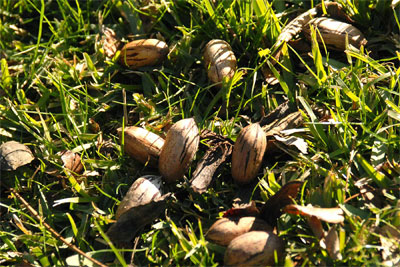From the Sperry Garden – December, 2007

We have been crunching pecans almost every time we’ve driven down the drive toward our home. It’s been a really good year for them, so I thought it might be a good time to give you one guy’s opinions of how you might want to maintain your own pecan planting.
Fertilizer: I use a highest-quality, all-nitrogen fertilizer on my lawn and landscape. Our pecans get whatever they can wrestle away from the rest of our plants. I fertilize in mid-spring, early summer and again in early fall, and that seems to be adequate for the pecans. On the other hand, pecan experts tell us that dedicated pecan orchards should receive ammonium sulfate in early March, early April and early May. Use whichever fits your situation.
Watering: Again, my pecans have to compete with my landscape and garden. However, I do water prudently, so they get all they need. If I want a really good pecan crop, the trees will have to have water in early summer, as the pecans expand, and in late summer, as they fill out. If it doesn’t rain, I have to supply it.
Pest Control: You need to divide this into two categories. Either you’re growing pecans for the yield, in which case you’ll want to follow the Texas A&M Cooperative Extension recommendations you can find online, or you are growing them primarily as large shade trees, in which case you can merely treat for pest outbreaks that threaten the health of your trees in general. That’s where I am, in that latter camp. My life is too short to be out there spraying for maximum pecan yield from my native trees. There are plenty of them that are of good quality to meet our family’s needs. Then again, I’m not counting on my pecan crop for a living. This is a decision you’ll have to make.
Pruning: I do very little pruning of my pecans other than to remove dead or damaged branches. I do remove lower limbs once in a while to allow more sunlight to reach in beneath the trees to my lawngrass and landscape plants. And, I use pruning as a means of eliminating webworms that develop. Rather than trying to spray high up into trees, I’ll use my long-handled pole pruner to snip them out at first sightings.

